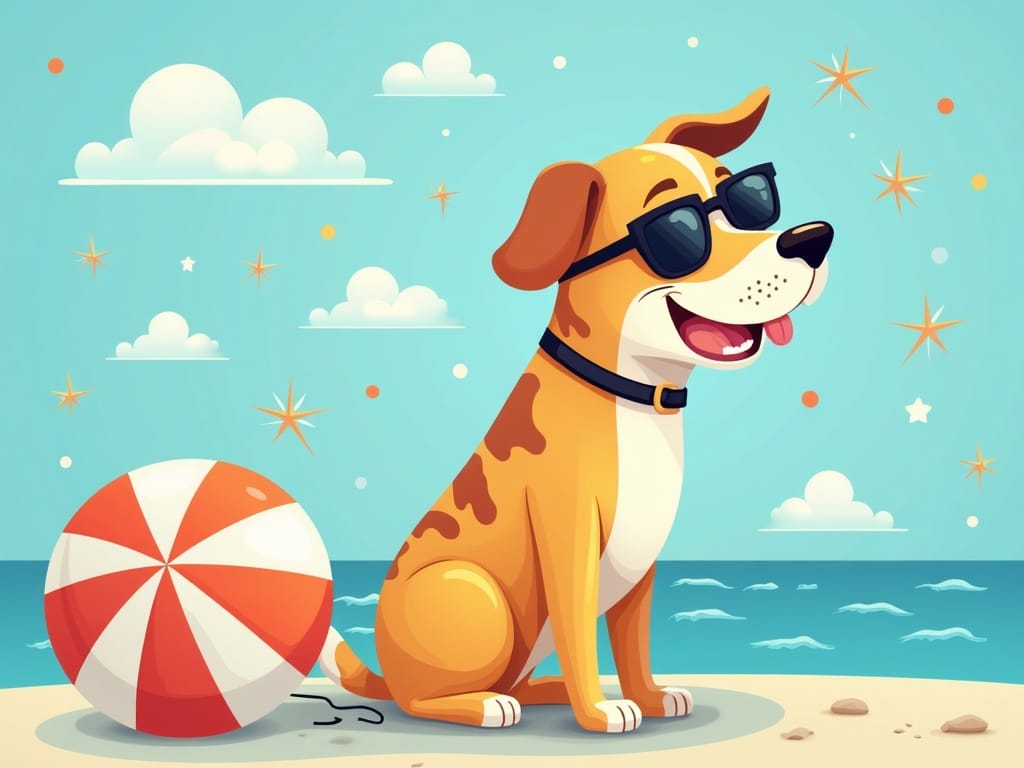Summer Dog Safety Secrets: Keep Your Pup Cool & Happy
Summer is a fantastic time to enjoy the outdoors with your furry companion. But along with the sunshine and fun come significant risks for dogs. High temperatures, hot pavement, and dehydration can quickly turn a joyful outing into a medical emergency. This guide covers crucial aspects of summer dog safety, providing essential tips to keep your pup cool, comfortable, and safe all season long.
Understanding Heatstroke in Dogs
Heatstroke is a severe and potentially fatal condition. Dogs don't sweat like humans, so they rely on panting to regulate their body temperature. This process becomes less effective in high humidity. Understanding the early signs of heatstroke, knowing which breeds are more susceptible, and recognizing the importance of panting are essential for responsible dog ownership.
Early Warning Signs of Heatstroke
- Excessive panting or difficulty breathing
- Drooling
- Weakness, staggering, or collapse
- Bright red gums
- Vomiting or diarrhea
- Seizures
Breeds Most Susceptible to Overheating
Brachycephalic breeds (those with short noses) like Bulldogs, Pugs, and Boxers, struggle more in the heat because their shortened airways make panting less efficient. Overweight dogs and those with thick fur coats are also at higher risk. Puppies and senior dogs have reduced ability to regulate heat, too.
How Panting Helps Dogs Cool Down
Panting allows dogs to evaporate moisture from their tongues and upper respiratory tract, which helps to dissipate heat. However, this method is much less effective in humid conditions, as the air is already saturated with moisture.
Normal Body Temperature for a Dog
A normal body temperature for a dog is between 101°F and 102.5°F (38.3°C and 39.2°C). If your dog's temperature exceeds 104°F (40°C), they are likely suffering from heatstroke and need immediate veterinary attention.
Hot Pavement Dangers
One of the most overlooked aspects of summer dog safety is the danger of hot pavement. Walking your dog on hot asphalt or concrete can lead to severe paw burns.
At What Temperature is Pavement Too Hot?
If the air temperature is 85°F (29°C), asphalt can reach a scorching 140°F (60°C). Pavement at 125°F (52°C) can cause burns in as little as 60 seconds.
How to Test the Pavement Temperature
Place the back of your hand on the pavement for seven seconds. If it's too hot for you to hold, it's too hot for your dog’s paws!
Signs of Paw Burns
- Limping or refusing to walk
- Licking or chewing at the paws
- Redness, blisters, or exposed skin on the paw pads
Safe Alternatives to Walking on Hot Pavement
- Walk your dog during the cooler parts of the day (early morning or late evening).
- Choose grassy or shaded routes.
- Use dog booties to protect their paws.
- Consider a dog stroller or carrier for longer distances.
How Long Does It Take Paw Burns to Heal?
Minor paw burns can heal within a week or two with proper care, including cleaning the paws and keeping them bandaged. Severe burns may require veterinary treatment and can take several weeks to heal.
Hydration is Key
Proper hydration is vital for summer dog safety. Dehydration can quickly lead to serious health issues.
How Much Water Should a Dog Drink Daily in the Summer?
A general guideline is that dogs need about one ounce of water per pound of body weight per day. This amount should increase during hot weather and after exercise.
Ways to Encourage Your Dog to Drink More Water
- Keep fresh water available at all times, both indoors and outdoors.
- Use a pet water fountain to make drinking more appealing.
- Add ice cubes to their water bowl.
- Carry a portable water bottle and bowl on walks.
- Try wet food to increase their fluid intake.
Can Dogs Get Dehydrated Even When Swimming?
Yes! Swimming is great exercise, but dogs can still get dehydrated. Ensure your dog takes breaks and drinks water regularly while swimming.
Signs of Dehydration in Dogs
- Dry nose and gums
- Sunken eyes
- Loss of skin elasticity (gently pinch the skin on their back – it should snap back quickly)
- Lethargy
Are Ice Cubes Safe for Dogs?
Yes, ice cubes are generally safe for dogs and can be a refreshing treat. However, avoid giving small dogs or those prone to dental issues very large ice cubes that they might try to bite and break.
Safe Summer Activities
With some planning, you and your dog can enjoy the warmer months safely.
Safe and Fun Outdoor Activities
- Early morning or late evening walks
- Swimming (if your dog enjoys it)
- Playing fetch in a shaded area
- Visiting dog-friendly splash pads
Best Time of Day for Walks
Early morning and late evening are the best times to walk your dog during the summer, as the pavement and air temperatures are cooler.
"Unlock the Secrets to a Blissful, Healthier Puppy: Discover the Benefits of Holistic Housebreaking"
Is Swimming Safe for All Dogs?
No, not all dogs are natural swimmers. Brachycephalic breeds and those with short legs may struggle. Always supervise your dog closely around water. Introduce swimming gradually and never force them.
Making Swimming Safer
Use a dog life vest, especially for inexperienced swimmers. Start in shallow water and gradually increase the depth as they become more comfortable. Rinse your dog off after swimming to remove chlorine or salt.
Can Dogs Get Sunburned?
Yes, dogs can get sunburned, especially those with light-colored fur or thin coats. Apply dog-safe sunscreen to exposed areas like the nose, ears, and belly, and limit their sun exposure during peak hours.
Car Safety
Never leave your dog unattended in a car during the summer!
Why is it Dangerous?
Even on a mild day, the temperature inside a car can rise rapidly to lethal levels. Cracking a window provides insufficient relief. Summer dog safety revolves around education and awareness of the risks.
Temperature Inside a Car on a Hot Day
On an 85°F (29°C) day, the temperature inside a car can reach 104°F (40°C) in just 10 minutes and 119°F (48°C) in 30 minutes.
Laws Regarding Leaving Dogs in Cars
Many states have laws against leaving animals unattended in vehicles under conditions that endanger their health. Violators can face fines and even criminal charges.
What to Do If You See a Dog Left in a Hot Car
Note the car's make, model, and license plate number. If the dog appears to be in distress, immediately contact local law enforcement or animal control. If authorities are delayed, and you believe the dog's life is in imminent danger, some states allow you to break into the car to rescue the animal (check your local laws first).
Cooling Products and Strategies
Various products and strategies can help keep your dog cool and comfortable during the summer.
Best Cooling Vests, Mats, and Bandanas
Cooling vests, mats, and bandanas use evaporative cooling or gel packs to help lower your dog’s body temperature. Look for products made from breathable, non-toxic materials.
How Cooling Vests Work
Cooling vests typically contain absorbent materials that you soak in water. As the water evaporates, it draws heat away from your dog’s body, providing a cooling effect. You can learn more here: Pet Dog Leash Walking Training Leash
DIY Cooling Mat
To make a DIY cooling mat, sew a fabric casing and fill it with water-absorbing polymer crystals (like those found in diapers). Soak the mat in water, and it will provide a cool surface for your dog to lie on.
Are Fans Effective for Cooling Dogs?
Fans can provide some relief by circulating air, but they are most effective when used in conjunction with other cooling methods, such as cooling mats or vests. Directing a fan at a wet dog will maximize the cooling effect.
Creative Ways to Keep Your Dog Cool Indoors
- Set up a kiddie pool filled with shallow water.
- Freeze water bottles and wrap them in towels for your dog to lie against.
- Keep the air conditioning running or use fans to circulate air.
- Provide plenty of shade and cool surfaces, such as tile or concrete floors.
Recognizing and Treating Heatstroke
Knowing how to recognize and treat heatstroke can potentially save your dog’s life.
How to Take a Dog's Temperature
Use a rectal thermometer lubricated with petroleum jelly. Gently insert it about one inch into your dog's rectum. A normal temperature is between 101°F and 102.5°F (38.3°C and 39.2°C).
Immediate Steps If You Suspect Heatstroke
- Move your dog to a cool, shaded area.
- Offer small amounts of cool water.
- Apply cool (not cold) water to their body, focusing on the groin, armpits, and neck.
- Use a fan to circulate air around them.
When to Take Your Dog to the Vet
Even if your dog seems to be recovering, take them to the vet immediately. Internal damage from heatstroke may not be immediately apparent.
Long-Term Effects of Heatstroke
Heatstroke can cause long-term organ damage, particularly to the brain, kidneys, and liver. Timely and appropriate veterinary care can minimize these effects.
Breed-Specific Considerations
Certain breeds need extra attention during the summer months.
Brachycephalic Breeds
Brachycephalic breeds (e.g., Bulldogs, Pugs) are highly susceptible to overheating. Keep them indoors during the hottest parts of the day and avoid strenuous exercise. You may find this interesting: Peace of Mind, One Walk at a Time: Investing in Your Dog's Nighttime Safety
Long-Haired Breeds
Long-haired breeds benefit from having their coat brushed regularly to remove excess fur. Consider a summer haircut to reduce heat retention.
Age and Weight
Puppies and senior dogs have a reduced ability to regulate their body temperature. Overweight dogs are also at a higher risk of overheating due to the extra insulation provided by their fat.
Avoiding Hot Spots
Protect your dog by avoiding certain areas during the summer.
Areas to Avoid
- Beaches without shade
- Crowded events
- Asphalt and artificial turf
Dog Parks
Dog parks can be dangerous in the summer due to the lack of shade and the potential for overexertion. Visit dog parks during the cooler parts of the day and ensure there is access to fresh water.
Creating Shade Outside
Provide shade for your dog using trees, umbrellas, or shade cloths. Make sure the shaded area is large enough to accommodate your dog comfortably.
Nutrition and Summer Safety
A dog's diet can affect its ability to tolerate heat.
Diet and Heat Tolerance
A balanced diet can contribute to your dog’s overall health and ability to regulate body temperature. Avoid feeding your dog heavy meals right before exercise in hot weather.
Cooling and Hydrating Foods
Offer cooling and hydrating foods such as watermelon, cucumber, and blueberries. These fruits are high in water content and can help keep your dog hydrated.
Frozen Treats
Frozen treats like dog-friendly popsicles or frozen broth cubes can be a refreshing way to keep your dog cool. Ensure there are no toxic ingredients present.
Foods that Increase Overheating Risk
Avoid giving your dog foods that are high in protein or fat right before or during exercise, as these can increase their metabolic rate and generate more heat.
Conclusion
By understanding the risks of summer heat and taking proactive measures, you can ensure that your dog stays cool, safe, and happy all summer long. Prioritize hydration, avoid hot pavement, recognize the signs of heatstroke, and adjust your activities to suit the weather conditions. With these summer dog safety tips, you and your furry friend can enjoy a fun-filled and worry-free season!


